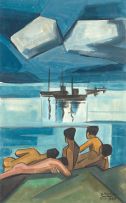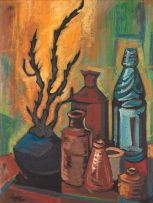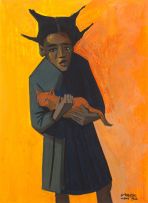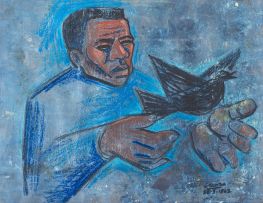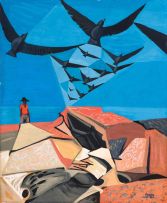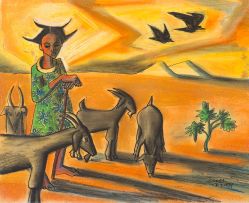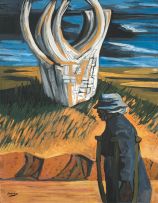Important South African and International Art, Decorative Arts & Jewellery
Live Auction, 16 October 2017
Evening Sale
Incl. Buyer's Premium & VAT
About this Item
signed and dated 17.1.1967; inscribed with the title and medium on the reverse
Notes
The shorelines of the Cape Peninsula figure strongly in Simon's Town-born Peter Clarke's work. The artist's earliest gouaches and watercolours from the mid-1940s include various descriptions of False Bay and Misty Cliffs. In 1952 he produced a vivid series of drawings of black beachgoers at Kalk Bay. Commenting on his marine landscapes, Philippa Hobbs and Elizabeth Rankin note: "Clarke's early scenes are aligned with a long tradition of Cape landscape painting that did not overly concern itself with social comment. These works did not reveal that South African beaches were socialised in another sense too, in that their use was proscribed by prejudice."¹
Clarke was, however, aware of that racial exclusivity affected certain beaches: for instance, Muizenberg and St James were frequented by predominantly white beachgoers, while Strandfontein and Kalk Bay, being nearer the harbour, were unofficially designated for black users. By the late 1960s, when this lot was produced, the implementation of so-called
"petty apartheid" entrenched these privileges. From the 1970s onwards Clarke made the indignity of apartheid an explicit subject of his work. This lot predates such overt visual activism.
Painted in the graphic style of his mid-career works, which feature clearly delineated forms and lines, this lot recalls Paul Cézanne's gregarious studies of naked male bathers from 1897-98, albeit that the mood in Clarke's work is wistful. Clarke may well be describing an actual day at the beach. A similarly coloured study of four bathers at Sandy Bay painted in oil in 1969 was the product of Clarke's attempts to avoid the throttling practice of segregation on beaches. Clarke and his friends would seek out remote beaches where they would not be harassed on account of their skin colour, including Sandy Bay. But this social comment is sublimated into a eye-tingling description of the beach as a place of revelry and provisional escape.
1 Philippa Hobbs and Elizabeth Rankin. (2014) Listening to Distant Thunder: The Art of Peter Clarke, Johannesburg: Standard Bank. Page 35.
Provenance
The Peter Clarke Private Collection

